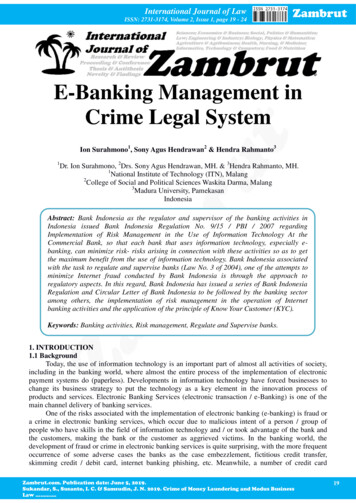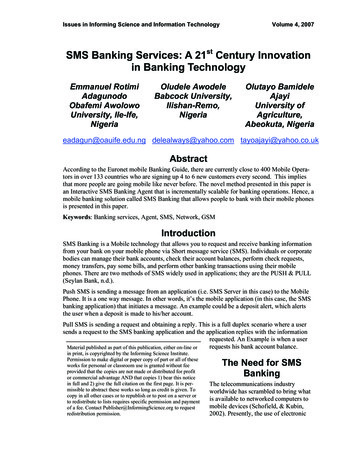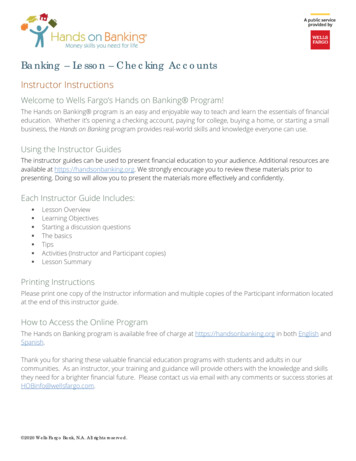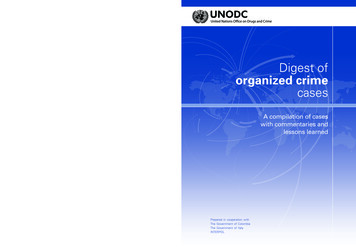
Transcription
International Journal of LawISSN: 2731-3174, Volume 2, Issue 1, page 19 - 24ZambrutE-Banking Management inCrime Legal SystemIon Surahmono1, Sony Agus Hendrawan2 & Hendra Rahmanto31Dr. Ion Surahmono, 2Drs. Sony Agus Hendrawan, MH. & 3Hendra Rahmanto, MH.1National Institute of Technology (ITN), Malang2College of Social and Political Sciences Waskita Darma, Malang3Madura University, PamekasanIndonesiaAbstract: Bank Indonesia as the regulator and supervisor of the banking activities inIndonesia issued Bank Indonesia Regulation No. 9/15 / PBI / 2007 regardingImplementation of Risk Management in the Use of Information Technology At theCommercial Bank, so that each bank that uses information technology, especially ebanking, can minimize risk- risks arising in connection with these activities so as to getthe maximum benefit from the use of information technology. Bank Indonesia associatedwith the task to regulate and supervise banks (Law No. 3 of 2004), one of the attempts tominimize Internet fraud conducted by Bank Indonesia is through the approach toregulatory aspects. In this regard, Bank Indonesia has issued a series of Bank IndonesiaRegulation and Circular Letter of Bank Indonesia to be followed by the banking sectoramong others, the implementation of risk management in the operation of Internetbanking activities and the application of the principle of Know Your Customer (KYC).Keywords: Banking activities, Risk management, Regulate and Supervise banks.1. INTRODUCTION1.1 BackgroundToday, the use of information technology is an important part of almost all activities of society,including in the banking world, where almost the entire process of the implementation of electronicpayment systems do (paperless). Developments in information technology have forced businesses tochange its business strategy to put the technology as a key element in the innovation process ofproducts and services. Electronic Banking Services (electronic transaction / e-Banking) is one of themain channel delivery of banking services.One of the risks associated with the implementation of electronic banking (e-banking) is fraud ora crime in electronic banking services, which occur due to malicious intent of a person / group ofpeople who have skills in the field of information technology and / or took advantage of the bank andthe customers, making the bank or the customer as aggrieved victims. In the banking world, thedevelopment of fraud or crime in electronic banking services is quite surprising, with the more frequentoccurrence of some adverse cases the banks as the case embezzlement, fictitious credit transfer,skimming credit / debit card, internet banking phishing, etc. Meanwhile, a number of credit cardZambrut.com. Publication date: June 5, 2019.Sukandar, S., Susanto, I. C. & Samsudin, J. N. 2019. Crime of Money Laundering and Modus BusinessLaw .19
International Journal of LawISSN: 2731-3174, Volume 2, Issue 1, page 19 - 24Zambrutholders have also complained, because the credit card number has been used other parties to conduct ecommerce transactions giving rise to substantial losses. Unrest-unrest, some communities require aguarantee fairness and legal certainty in the field of cyber-crime in the use of services E-Banking.1.2 Formulation of the problemBased on this background, it formulated some discussion of the problem in this paper:a. Any examples of crime on the system E-Banking?b. Any risks in the use of E-Banking services?c. How evil handling of E-Banking on the legal system in Indonesia?1.3 Troubleshooting MethodsBased on the formulation of the problem, then the troubleshooting methods used in this paper isto study literature is to take reference from the book, a journal of the E-Banking and also from theinternet1.4 Goal Writing PapersThe purpose of this paper is as reference material about handling a knowledge of Crime EBanking Legal System in Indonesia2. DISCUSSION2.1 Risks in the use of E-Banking ServicesIn its development, E-banking has benefited the banking world, but on the other hand there arealso risks inherent in the service.E-banking not only provide benefits to those who organized it, but there are risks to be faced onthe implementation of E-banking. The risk is the risk of technological reliability level E-banking andrisk of the degree of legal protection can be provided as a result of the implementation of E-banking.Attachment of Bank Indonesia Circular Letter No. 6/18 / DPNP on Guidelines for RiskManagement At Bank Service Activities Through the Internet (E-Banking), explaining that the activityof bank services through the internet, banks are faced with several risks such as:a. Strategic Riskb. Reputation riskc. Operational risk (which includes security risk and the law)d. Credit riske. Market riskf. Liquidity Riskg. Privacy Risks2.2 Crimes E-Banking Legal System in IndonesiaThe setting is now applied in the implementation of E-banking is divided into two kinds ofmodels, namely self-regulation and government regulation. Self-regulation that rules that typicallyformed the party in anticipation of a legal vacuum (the vacuum of law) for the protection of personaldata, while government regulation is a rule that typically established by the government in the form oflaws or decisions to protect personal data and bank.Bank is an institution of trust, in the course of electronic banking (e-banking) should also beheld with the provisions and principles of prudence and risk management related to the implementationof e-banking especially a reputation risk and legal risk. E-banking is a delivery channel in the bankingindustry, and civil relations that exist with respect to e-banking accounts in the form of the relationshipbetween the bank and its customers. In this case, the legal issues will arise if electronic transactions thatdo fail, who should be responsible for the failure of these transactions?. An understanding of theresponsibilities of the actors began their legal relationship that occurs between the two sides in anengagement.In Indonesia, in addition to the agreement governing civil relationships, positive law governingthe responsibility for holding the electronic transaction is UU ITE. In order to protect consumers, UUZambrut.com. Publication date: June 5, 2019.Sukandar, S., Susanto, I. C. & Samsudin, J. N. 2019. Crime of Money Laundering and Modus BusinessLaw .20
International Journal of LawISSN: 2731-3174, Volume 2, Issue 1, page 19 - 24ZambrutITE organize their neutral technology that is used in electronic transactions, as well as the agreementrequires the use of electronic systems used. In addition, each organizer of the electronic system isrequired to provide an electronic system reliably and safely and is responsible for the operation of theelectronic system as it should be. Organizers of the electronic system is responsible for theimplementation of the electronic system. However, the provision does not apply in the case of forcemajeure can be proved of error.ITE Law also provides that to the extent not otherwise stipulated by a separate law, the conduct ofthe electronic systems required to operate the electronic system that meets the following minimumrequirements:a. Can redisplay electronic information and / or electronic documents in full accordance with theretention period specified by the Regulatory Invitationb. Can protect the availability, integrity, authenticity, confidentiality, electronic information in theimplementation of the electronic systemc. Can operate in accordance with the procedures or guidance in the implementation of the electronicsystemd. Equipped with the procedure or instructions be announced with language, information, or symbolsthat can be understood by the parties concerned with the implementation of an electronic systeme. Having a sustainable mechanism to keep the novelty, clarity, and accountability procedures orinstructionsRelated to the party conducting electronic transactions arranged that the sender or recipient canconduct electronic transactions themselves, through the parties, or through an electronic agent. In thiscase the parties are responsible for all legal consequences in the implementation of electronictransactions are:a. If done alone, all legal consequences in the implementation of electronic transactions is theresponsibility of the parties to a transactionb. If done through the provision of power, all legal consequences in the implementation of electronictransactions is the responsibility of the authorizingc. If done through an electronic agent deploy all legal consequences in electronic transactions is theresponsibility of the organizers of the electronic agentd. If the loss is due to failure of electronic transactions operated a electronic agent as a result of actionsof third parties directly to the electronic system, all legal consequences are the responsibility of theorganizers of an electronic agent.e. However, if the electronic transaction losses caused by failed operation of electronic agents due tonegligence of the service users, all law consequence is the responsibility of the service users. Theprovision does not apply in the case can be proved the occurrence of force majeure, errors and / oromissions of the users of electronic systemsMeanwhile, in order to provide protection and security to the licensing of electronic transactions,in line with the ITE Law, Bank Indonesia has issued a variety of settings (regulation) related to the useof information technology for banking and payment systems provider institution in the form of BankIndonesia Regulation and Circular Letter of Bank Indonesia. The settings are, among others, aimed toimprove the security, data integrity, and availability of electronic banking services, for example byrequiring all card issuers to use the chip in the cards payment, using 'two factors authentication' in online transactions that are financially, encrypts E-banking transactions.Bank Indonesia associated with the task to regulate and supervise banks (Law No. 3 of 2004), oneof the attempts to minimize Internet fraud conducted by Bank Indonesia is through the approach toregulatory aspects. In this regard, Bank Indonesia has issued a series of Bank Indonesia Regulation andCircular Letter of Bank Indonesia to be followed by the banking sector among others, theimplementation of risk management in the operation of Internet banking activities and the applicationof the principle of Know Your Customer (KYC).a. Risk management in the implementation of the activities E-banking issued by Bank Indonesiarelated to the management or operation of the risk management activities of internet banking is BankIndonesia Regulation No. 5/8 / PBI / 2003 regarding Implementation of Risk Management forCommercial Bank and Bank Indonesia Circular Letter No. 6/18 / DPNP, April 20, 2004 regardingZambrut.com. Publication date: June 5, 2019.Sukandar, S., Susanto, I. C. & Samsudin, J. N. 2019. Crime of Money Laundering and Modus BusinessLaw .21
International Journal of LawISSN: 2731-3174, Volume 2, Issue 1, page 19 - 24ZambrutRisk Management At Bank Service Activities Through the Internet (E-Banking). The main pointsinclude the following settings:1) Bank internet banking which organizes activities required to implement risk management inbanking internet activities effectively2) Application of risk management shall be set out in a policy, procedures and guidelines writtenwith reference to the Guidelines for Application of Risk Management Activities Bank ServiceOver the Internet (Internet Banking), set out in the annex in the Bank Indonesia Circular Letter.The principal application of risk management for banks conducting internet banking are: Theexistence of active supervision of commissioners and directors of the bank, which include: (1)the Commissioner and directors must conduct effective oversight of the risks associated with theactivity of internet banking, including the establishment of accountability, policies and processcontrols to manage those risks, (2) the Board of Directors must approve and carry out a reviewof the main aspects of the bank security control procedures.While controlling the security (security control) include:a) Should undertake adequate steps to verify the authenticity (authentication) the identity andauthorization of the customers who make transactions via internet banking.b) Banks should use the method of testing the authenticity of the transaction to ensure that thetransaction can not be denied by the customer (non-repudiation) and assign responsibility ininternet banking transactions.c) Banks must ensure the separation of duties in internet banking systems, databases and otherapplications.d) Banks must ensure their control over the authorization and access rights (privileges) the rightto internet banking systems, databases and other applications.e) Banks must ensure the availability of adequate procedures to protect the integrity of the data,records/ archives and information on internet banking transactions.f) Banks should ensure the availability of tracking mechanisms (audit trail) that is clear for allinternet banking transactions.g) Banks should take steps to protect the confidentiality of critical information on internetbanking. The measures must be in accordance with the sensitivity of the information releasedand / or stored in a database.Legal Risk Management and Reputation Risk:a) Banks should ensure that the bank's website provides information that allows potentialclients to obtain accurate information concerning the identity and legal status of the bankbefore making transactions through e-banking.b) Banks must take steps to ensure that the customer confidentiality provisions are applied inaccordance with applicable in the country where the bank provides products and services Ebanking.c) Banks must have contingency planning procedures effective and continuous efforts to ensurethe availability of systems and
E-Banking Management in Crime Legal System Ion Surahmono1, Sony Agus Hendrawan2 & Hendra Rahmanto3 1Dr. Ion Surahmono, 2Drs. Sony Agus Hendrawan, MH. & 3Hendra Rahmanto, MH. 1National Institute of Technology (ITN), Malang 2College of Social and Political Sciences Waskita Darma, Malang 3Madura University, Pamekasan Indonesia 1. INTRODUCTION 1.1 Background Today, the











